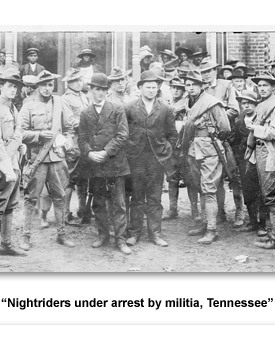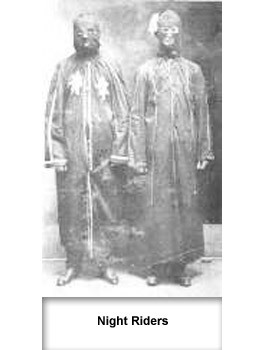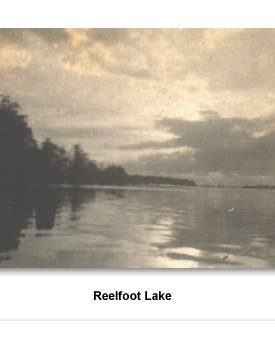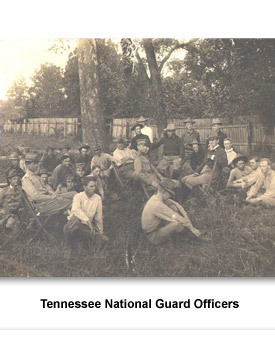Reelfoot Night Riders
A controversy over who had rights to develop or fish in Reelfoot Lake in northwestern Tennessee turned to violence in 1908.
The lake, which was twenty miles long and seven miles wide, served as a livelihood for local residents who fished in it or farmed next to it.
The disagreement began in 1899 when James Harris announced that he had bought up all the land underneath and around the lake, and that he was going to drain the lake. Local residents banded together and sued Harris in court to try and stop him.
At the heart of the suit was the question of whether or not the lake was navigable –could a boat safely cross it. If it was navigable, then by the state constitution, it was public land and Harris couldn't drain it.
The Tennessee State Supreme Court ruled in 1902 that the lake was too shallow to be navigable. Harris died the next year, but his son, Judge Harris, formed the West Tennessee Land Company in 1907 to develop the land.
The company tried to force farmers who had been farming around the lake for years to pay the company rent. The 500 families who earned their money either fishing or farming around the lake felt cheated. They tried to get the courts to allow them to fish in Reelfoot Lake, but the judge refused. Some of the people turned to unlawful methods.
Night Riders formed
The local residents had read about night riders in the Black Patch War in Middle Tennessee and Kentucky. Although that situation was still ongoing, the actions of local farmers so far had shocked the local officials into studying their needs. It seemed like a good example to the Lake County residents.
Two prosperous farmers, Tom Johnson and Tom Wilson, along with Johnson’s cousin, Garrett Johnson, formed the Lake County Night Riders. Eventually hundreds became involved.
Meetings were held in local homes and participants were sworn to secrecy. The majority were farm owners, hired hands, and -sharecropper-s with a few fishermen. Some members were forced to participate. Before long, men with criminal backgrounds also joined.
Violence
In the seven months from April to October 1908, the riders brought an atmosphere of terror and violence to the Reelfoot Lake area. While their main targets were Harris and the land company, sometimes members attacked people for personal reasons. Mrs. Emma Johnson was dragged out of her home and whipped by men dressed as riders because she had sued her husband, a rider, for divorce.
Harris sent his family to Nashville to live and turned his home into a fortified area, including placing mines in his front yard. While the riders didn’t attack his home, they did burn the company’s boat dock.
A later incident was even more deadly. A group of riders went to Kentucky to find a black man from Hickman County who had reportedly insulted a white woman and pulled a gun on a white man. The man, Dave Walker, had taken his family to Kentucky to hide, but the riders found them there.
When he refused to come out of his barricaded cabin, the riders set it on fire. As Walker came out, he was shot and killed. They then shot his family as they fled the flames. His wife was killed along with the baby she was holding. Walker’s 12-year-old daughter was gunned down and killed. The other three Walker children were also shot, but survived.
Although there was some outcry against the Walker murders in Kentucky, no legal action was taken against the riders. However, the murder of a white man in October of 1908 did cause Tennessee officials to react.
Murder of Quentin Rankin
Two of the land company’s attorneys, Robert Taylor and Quentin Rankin, agreed to meet with a local businessman. They were overheard by a rider. The group made plans to take the two men after the meeting. They probably didn’t intend to murder anyone, but events got out of their control.
The riders took the two men from their beds and marched them away. The plan had been to threaten them with a hanging if the men didn’t restore free fishing to Reelfoot Lake. They placed a noose over Rankin’s neck and pulled him up, choking him. They then let him down and asked if he would restore free fishing.
Both Rankin, 39 years old, and Taylor, 63 years old, refused. They raised and lowered Rankin several times. Finally someone opened fire, hitting Rankin several times, killing him.
As the riders were arguing about what to do, Taylor broke away and jumped into a drainage ditch, going under the water. The riders opened fire on the water. When Taylor’s body didn’t come up, they assumed he was dead, and fled the scene. Taylor was not dead, however, and was later found.
The general public was outraged. Governor Malcolm Patterson offered a reward and called out the state militia . The sheriff of Obion County led a posse into Lake County to help find the culprits–an incursion which had not been requested by the sheriff of Lake County.
The result was chaos. militia arrested suspected riders and innocent men alike, including an outraged friend of Gov. Patterson who had been an outspoken opponent of the riders.
A group of 32 men were eventually charged with Rankin’s murder. The state decided to try the eight whom they thought were most involved in the murder. This included Garrett Johnson. The state managed to get some of the riders to testify against the eight and in the end all were found guilty. Six, including Johnson, were sentenced to death. The other two received 20 year sentences.
None of the men ever served their sentences. The Tennessee Supreme Court overturned the trial verdicts in July, 1909. According to the ruling, the trial judge had not followed the correct jury selection procedure. Two other trial juries couldn’t agree on a verdict. No one was ever punished for Rankin’s murder.
The Night Riders never rode again. Perhaps they were afraid after the close call with the justice system. In any case, they didn’t need to ride. In another case, the State Supreme Court ruled that Reelfoot Lake was navigable, and therefore all land titles to the lake were invalid. Reelfoot Lake belonged to the state, and fishing was again free.
The West Tennessee Land Company only received compensation for a small part of their land. Judge Harris drowned in Reelfoot Lake in 1913. The drowning was ruled accidental.
Picture Credits:
- Photograph with the caption, “Nightriders under arrest by militia, Tennessee.” It shows two men surrounded by a group of uniformed guards. Numerous people can also been seen watching in the background. Library of Congress.
- Photograph of the jury for the Night Rider trials. This photo was taken in 1908 in Union City, Tennessee. Tennessee State Library and Archives.
- Photograph of two men dressed as Night Riders. This photo was taken in 1908 in Trenton, Tennessee. Tennessee State Library and Archives.
- Photograph of the Tennessee National Guard Officers. This photo was taken in 1907 in Waverly, Tennessee. The group is shown seated near a tree. The man with his right hand on the back of the chair is Col William Clinton Tatom. The Tennessee State Library and Archives.
- Photograph of Reelfoot Lake. This photo was taken in 1922. Tennessee State Library and Archives.
Confronting the Modern Era >> Life in Tennessee >> Getting a Fair Share >> Reelfoot Night Riders





 Sponsored by: National Endowment for the Humanities
Sponsored by: National Endowment for the Humanities